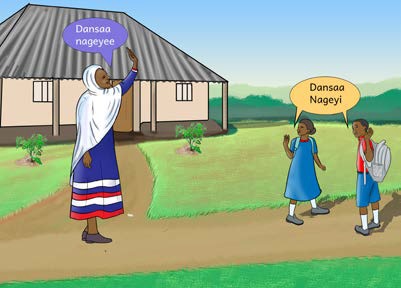A Triumph for the Burji!
In a significant milestone for the Burji community, the Burji language has found its place in Kenyan schools through the introduction of primary school books.
This remarkable achievement is the culmination of a journey that began with the launch of the Burji Language Course at the Buruuj Training Institute.

The initiative to formalize the teaching of Burji took a significant step forward when a letter was sent to TVET CDACC by Buruuj Training Institute with the vision of creating an official curriculum for college-level Burji Language instruction.

TVET CDACC, in response, redirected the endeavor towards the Kenya Institute of Curriculum Development (KICD), the recognized authority for native languages in Kenya.
In June 2023, KICD put together a team of Burji Language speakers for the Book. The team, consisting of Dawa Daud Garse, Wache Summa, and Tego Wolasa, embarked on the mission under the guidance of KICD.

The journey wasn’t without its share of challenges. The first major hurdle was deciding on the name for the language itself – a contentious issue within the Burji community. The dilemma of choosing between “Burji” and “D’aashi” was resolved after consultations with KICD, determining that the official and registered name in Kenya is “Burji.” Hence, the name “Burji Language” was deemed the most appropriate.
The second challenge lay in selecting the dialect for the primary school books. Given the grade one level, it was essential to teach in a single dialect to avoid confusion.

Following KICD’s guidance, the dialect spoken by the majority of Burji speakers in Kenya was chosen. In Kenya, the Gubba dialect, spoken predominantly, was the clear choice.
However, a unique predicament emerged as team members, Dawe Garse and Tego Wolasa, spoke the Southern (Gul) dialect, while Wache Summa had roots in Lemmo, also within the Gul semi-automatic region but could fortunately speak the Gubba dialect. This choice laid the foundation for the books’ content.
The creation of a comprehensive five-chapter book was a laborious but rewarding endeavor, taking a week to piece together. The illustrations were skillfully crafted by the KICD Graphics team.

Simultaneously, numerous teams of native language speakers embarked on similar tasks, working from English versions of the book, provided for translation.
The team also meticulously prepared a teacher’s guide for the grade one book, which was submitted at the end of the one-week period.
Weeks later, KICD assembled a secondary team to edit the material. Notably, the editing team included Beko Ibrahim Moru, Hirbo Wolasa, and Tego Wolasa for the Burji Language books.

The editing and revision of the drafts took less than a week, with the dedicated team working diligently, even during the 2023 Eidul Hajj celebrations.
A significant development in this endeavor was the creation of new vocabulary. To assist in this crucial task, the team had the expertise of Mzee Wolasa Hassa, Dube Sago, and Mzee Siko from Marsabit at their disposal. The Burji language, surprisingly, lacked basic terms that were expected to be straightforward.
The team adopted and introduced essential terms, such as “Kolee Bochee” for blackboard, “Shichisa” for pen, “T’iifenda Shichisa” for pencil, “Shichi” for write, “Shichanchi” for book, “Shichanchi Shiidis” for read, “Solaa” for class, “Sherdoo” for handkerchief, “Sessaano” for shape, “Wod’aa” for theme/chapter, and “Irk’anka saamunaa” for toothpaste to mention a few.

The books are now set for an official rollout in Kenyan schools through KICD’s established channels, in line with their policies. The journey doesn’t end here, as further development is expected, with plans for grade two books and expansion into senior classes on the horizon.
This accomplishment stands as a testament to the unwavering dedication and commitment of the Burji community in preserving and promoting their language and culture.

The Burji language books are poised to make a tangible difference in the lives of Burji children, providing an opportunity to learn and grow in their native language, marking a significant step towards linguistic and cultural preservation.
As we eagerly anticipate the Burji language books’ presence in Kenyan schools, the Burji community can take pride in the invaluable resource they have created for future generations, ensuring the continuity of their rich linguistic heritage.


Good News????????????????
Good News????????????????
Good morning,where can I get the book, currently am in Nairobi
KICD in Ngara.
This book is good to elevate &develop our language .upon all burjese to get this for there intentionally for this out of the burje county .
Upon writers all so to distribute in all Kenyan county and adjacent Ethiopia people
thank you.
Wow
Thank you.
How can I get it?
Kenya institute of Curriculum development in Ngara
Great job guys,our language will not be assimilated now…keep on kindly share the link to the book also
Great work! What a service for the community. Kudos guys.